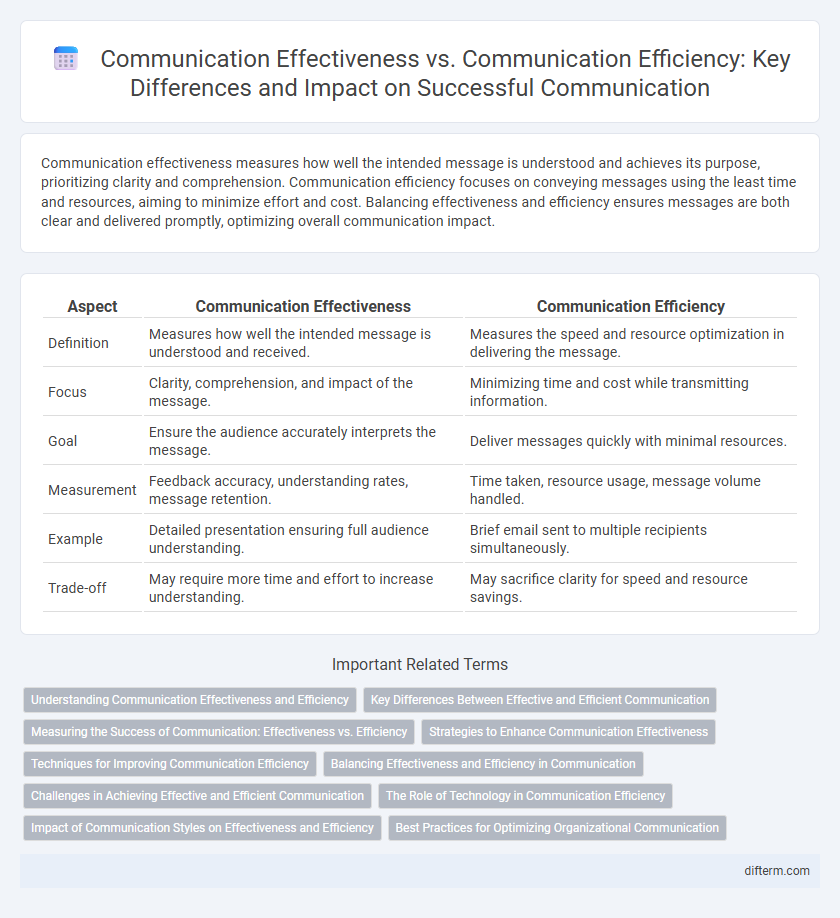Communication effectiveness measures how well the intended message is understood and achieves its purpose, prioritizing clarity and comprehension. Communication efficiency focuses on conveying messages using the least time and resources, aiming to minimize effort and cost. Balancing effectiveness and efficiency ensures messages are both clear and delivered promptly, optimizing overall communication impact.
Table of Comparison
| Aspect | Communication Effectiveness | Communication Efficiency |
|---|---|---|
| Definition | Measures how well the intended message is understood and received. | Measures the speed and resource optimization in delivering the message. |
| Focus | Clarity, comprehension, and impact of the message. | Minimizing time and cost while transmitting information. |
| Goal | Ensure the audience accurately interprets the message. | Deliver messages quickly with minimal resources. |
| Measurement | Feedback accuracy, understanding rates, message retention. | Time taken, resource usage, message volume handled. |
| Example | Detailed presentation ensuring full audience understanding. | Brief email sent to multiple recipients simultaneously. |
| Trade-off | May require more time and effort to increase understanding. | May sacrifice clarity for speed and resource savings. |
Understanding Communication Effectiveness and Efficiency
Communication effectiveness measures how well the intended message achieves its purpose and resonates with the audience, ensuring clarity and comprehension. Communication efficiency focuses on the speed and resource optimization in delivering the message, minimizing time and effort without compromising essential content. Balancing effectiveness and efficiency is crucial for maximizing impact while conserving communication resources.
Key Differences Between Effective and Efficient Communication
Effective communication prioritizes clarity, understanding, and message retention, ensuring the intended meaning is accurately conveyed and received. Efficient communication emphasizes speed and resource optimization, delivering messages quickly with minimal effort or waste. While effectiveness measures the quality of interaction, efficiency focuses on the process's time and cost, making both essential but distinct in achieving optimal communication outcomes.
Measuring the Success of Communication: Effectiveness vs. Efficiency
Measuring the success of communication requires analyzing both effectiveness and efficiency to achieve optimal outcomes. Communication effectiveness focuses on the clarity, comprehension, and impact of the message on the target audience, ensuring intended meaning is conveyed accurately. Communication efficiency emphasizes the speed, resource utilization, and minimal effort needed to transmit information, aiming to reduce costs and time in the communication process.
Strategies to Enhance Communication Effectiveness
Strategies to enhance communication effectiveness focus on clarity, active listening, and audience engagement to ensure messages are understood as intended. Employing feedback mechanisms and tailoring content to the audience's needs reduces misunderstandings and improves information retention. Prioritizing quality interactions over speed leads to more meaningful exchanges, increasing overall communication impact.
Techniques for Improving Communication Efficiency
Techniques for improving communication efficiency emphasize reducing redundancy and streamlining message delivery through tools like concise language, active listening, and digital platforms that enable instant feedback. Implementing standardized templates and leveraging automation can minimize misunderstandings and speed up information exchange. Prioritizing clarity and brevity ensures messages are quickly understood, maximizing productivity without sacrificing communication effectiveness.
Balancing Effectiveness and Efficiency in Communication
Balancing effectiveness and efficiency in communication requires delivering clear, meaningful messages while minimizing time and resource expenditure. Prioritizing communication effectiveness ensures that the intended message is accurately understood and achieves its purpose, whereas focusing solely on efficiency may lead to misunderstandings or incomplete information. Integrating these two aspects enhances overall communication quality, fostering better collaboration and decision-making.
Challenges in Achieving Effective and Efficient Communication
Achieving effective and efficient communication faces challenges such as message distortion, information overload, and differing interpretations among recipients. Barriers like language differences, cultural misunderstandings, and limited feedback mechanisms further hinder clarity and speed of information exchange. Overcoming these obstacles requires targeted strategies to balance accuracy with timeliness in conveying messages.
The Role of Technology in Communication Efficiency
Technology enhances communication efficiency by streamlining information exchange through tools like instant messaging, video conferencing, and automated workflows. These innovations reduce time delays, minimize errors, and enable real-time collaboration across diverse locations. As a result, organizations achieve faster decision-making and improved productivity while maintaining clarity and accuracy in their communication processes.
Impact of Communication Styles on Effectiveness and Efficiency
Communication effectiveness hinges on the message clarity and audience understanding, directly impacting goal achievement. Communication efficiency focuses on optimizing resources and time spent transmitting information without sacrificing clarity. Different communication styles influence both effectiveness and efficiency by either facilitating quick comprehension or causing misunderstandings that lead to delays and increased effort.
Best Practices for Optimizing Organizational Communication
Effective communication ensures clarity, understanding, and engagement within an organization, while efficient communication minimizes resource use and time. Best practices for optimizing organizational communication include tailoring messages to the audience, utilizing appropriate channels, and regularly gathering feedback to refine processes. Emphasizing clarity and relevance enhances both effectiveness and efficiency, driving better collaboration and decision-making.
communication effectiveness vs communication efficiency Infographic

 difterm.com
difterm.com